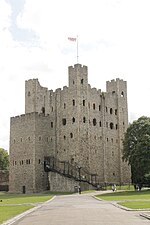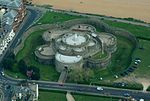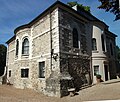Kentish ragstone is a hard grey limestone in Kent, England, drawn from the geological sequence known as the Hythe Beds of the Lower Greensand. For millennia...
28 KB (3,020 words) - 03:58, 2 October 2023
close to the curtain wall. The primary building material was local Kentish Ragstone; Caen stone used to face the keep was imported from Normandy. The same...
60 KB (8,068 words) - 15:30, 10 September 2024
city wall is the largest surviving city gate in England. Built of Kentish ragstone around 1379, it is the last survivor of Canterbury's seven medieval...
20 KB (1,962 words) - 20:56, 1 September 2024
bastion walls are 15 feet (4.6 m) thick. It was constructed using Kentish ragstone from near Maidstone, locally made bricks and Caen stone recycled from...
34 KB (4,071 words) - 10:59, 29 August 2024
It had gateways, towers and defensive ditches, and was built from Kentish ragstone, which was brought by barge from quarries near Maidstone. It was 2...
61 KB (4,556 words) - 03:10, 2 September 2024
traditional peg tiles are on the roofs and the walls are faced in Kentish ragstone. The priory is a popular place for pilgrimage, as well as for retreats...
23 KB (2,636 words) - 10:42, 17 October 2024
wall separates the road from the grounds. The building is built from Kentish Ragstone, a limey sandstone dating from the Cretaceous period. This stone gives...
2 KB (250 words) - 02:11, 22 February 2023
known about its original appearance and dimensions. It was built using Kentish Ragstone with external flint courses and mouldings made from Reigate Stone....
25 KB (3,359 words) - 14:17, 29 July 2024
2nd century, the 5-level 8-sided tower was made of layers of tufa, Kentish ragstone, and red bricks. The castle lighthouse survived after being converted...
24 KB (2,511 words) - 14:59, 10 October 2024










